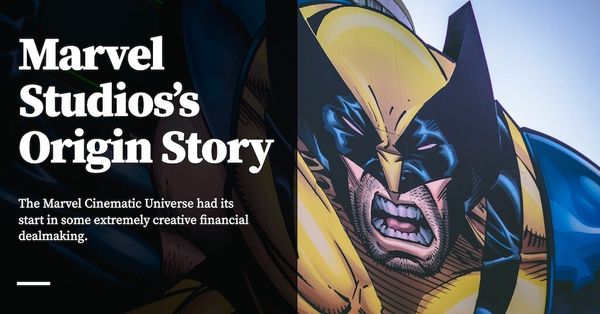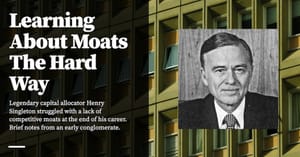This is Part 10 in a series on the expertise of capital in business. You may read the previous part here.
We’re entering the last stretch for the Capital Expertise series now. As we wind down, I’d like to dial up the fun.
At the start of the series, a couple of months ago, we walked through a series of cases that showcased Michael Dell’s expertise with the capital side of the business expertise triad. What I found entertaining about that journey was the fact that Dell Computers wasn’t a business that many would associate with capital expertise in the first place.
Today, we have another story that’s similar in that sense. Did you know, for instance, that Marvel Studios — and by extension the entire Marvel Cinematic Universe — was formed as the result of some extremely creative financial dealmaking?
The following case tells that origin story, and returns to an earlier theme of our series — that of skill in raising capital.
David Maisel and the Creation of Marvel Studios
The long list of closing credits to Avengers: Age of Ultron included a curious line:
“Special Thanks to Marvel Studios Founding Chairman David Maisel”
If the name David Maisel has you scratching your head in confusion, don’t worry. Most people haven’t heard of the founder of the $50 billion movie studio. In Maisel’s own words:
“Most people right now think Kevin [Feige] started the studio…They don’t know me at all.”
And indeed there’s very little publicly tying David Maisel to Marvel Studios; a 2016 Hollywood Reporter article pointed out that the only outward acknowledgement of Maisel was that one line at the end of Age of Ultron.
Origin stories are of incredible importance in Marvel’s superhero movies. As it turns out, the Marvel Cinematic Universe has a fascinating one of its own, a story in which David Maisel plays a leading role.
A brief sketch, if you’ll indulge us: the opening scene stars Maisel, comfortably dressed in sweatpants, at his LA loft on a summer weekend circa 2003. At the time, working as a talent agency executive, Maisel is plotting his next career move. He wants to run a movie studio. However, Maisel has worked in the entertainment business for long enough to know that making films is a pretty terrible business to be in. It’s hit or miss. One could spend $100 million making a movie, with a good chance that it would still tank at the theaters. But Maisel has a novel idea:
“...Hey, if I can get a movie I can believe in, and every movie after that one is a sequel or a quasi-sequel — the same characters show up — then it can go on forever. Because it’s not thirty new movies. It’s one movie and twenty-nine sequels. What we call a universe.”
Dim the lights, cue the catchy soundtrack — the Marvel Cinematic Universe (also known as the “MCU”) is born.
Maisel’s love for showbiz dates back to when he was a high school student trying out theater. Never the most skilled actor, he sensed that a successful future in the entertainment business lay somewhere at the intersection between art and commerce. Maisel kept these aspirations alive through his college years. When he was at Duke University, he produced the “Broadway at Duke” series. Maisel earned a business degree from Harvard before securing a job consulting for entertainment companies at BCG.
When Maisel’s older sister passed away from lupus, it was a wake-up call for the young consultant. The tragedy was a reminder that life was fleeting. Maisel wasn’t happy spending it watching the action from the sidelines; he wanted to work in Hollywood. He quit his job at BCG, moved back with his mother, and started looking for a way inside.
Maisel chanced upon a cover-story of Michael Ovitz, the head of a leading talent agency, in a 1993 issue of Businessweek. At the time, Ovitz had the towering reputation of being the most powerful man in Hollywood. Maisel decided to take his chances, sending Ovitz a letter and his resume. He was pleasantly surprised when Hollywood’s power broker granted him an interview. After months of back and forth, Ovitz hired Maisel as a consultant for his agency, the Creative Artists Agency (or simply, “CAA”). (Interesting side-note: In the interim, Maisel explored job opportunities with the NBA and McKinsey. The MCU as we know might not exist if he had taken either of those jobs!)
Maisel got really lucky when he landed the job with Ovitz. He would later discover that the timing of his letter was just right. Around this time, Ovitz himself had been hired by a Japanese company called Matsushita to analyze the sale of their holdings in Universal Studios. Maisel was exactly the kind of person Ovitz was looking for. He was young, hungry to learn, had a flashy HBS degree, and a few years of work experience at a consulting firm. When Ovitz hired Maisel, he made it clear that it was going to be a gamble. Maisel remembers it clearly:
“In fact, when Michael offered me the job, he said, “What are you making at McKinsey?” I told him and he said, “We’ll match that, but there’s no guarantee, and I can fire you tomorrow.” It was a gamble. It was definitely a gamble.”
Lucky for Maisel, the gamble worked out in his favor. The potential sale of Matsushita’s stake in Universal Studios was highly confidential. Maisel, the newest employee, was also privy to CAA’s biggest secret. He worked very closely with Ovitz, learning lessons that would prove to be invaluable in his career. Maisel learned how to work with creative people like actors and directors. For instance, Ovitz reminded him that Hollywood was a service industry, and warned him against losing sight of who the agency’s client really was. Maisel was also influenced by Ovitz’s intense focus on technology. Ovitz was particular about keeping abreast of advances in technology, and keenly tracked how they could be applied to entertainment. Maisel also learned how to be street-smart; finding out what people wanted and leveraging it to his advantage.
Eventually, Matsushita sold its stake in Universal to Seagram in 1995. Ovitz was supposed to get the job of running Universal, but he lost out to his own partner at CAA. Just when everybody expected Ovitz to stay put at the agency, he sent shockwaves through the industry by leaving to become the president of Disney.
Before leaving, Ovitz offered Maisel a job at Disney. Maisel accepted. He was assigned to Disney’s corporate development group, a place where the strategic decisions of the company were centralized. One of his responsibilities was to recommend acquisitions that would add value to Disney. In around 1997, Maisel suggested that Disney acquire Marvel Studios. He had noticed a gap in the life cycle of every Disney consumer. Most fans lost interest in Disney characters when they turned 12 years old, only becoming consumers once again when they had young children of their own. Maisel thought Marvel could plug that gap. His idea was unceremoniously shot down.
Spoiler alert: Disney would in fact acquire Marvel Studios a little over a decade later in 2009, however, by then, Maisel would be on the other side of the transaction.
After a brief stint at Disney, Ovitz was dramatically fired from the company in 1998. Maisel also left with him, joining Ovitz’s new production venture. The pair produced a Tony-Award-winning Broadway show called Foss, giving Maisel an opportunity to develop the creative chops that would serve him well later in his career.
Maisel bounced around for the next few years before settling down in LA at an agency called Endeavour. This brings us full-circle to the summer afternoon in 2003 when Maisel had his golden idea about sequels:
“But the sequel business was amazing because statistically, you could predict the revenues plus or minus something, and you could manage your profit margin, not whether you made profits.”
Marvel Studios owned the IP rights to enough characters to support a universe built around them. Moreover, Maisel held stock in Marvel. He had closely tracked the studio’s releases, the first X-Men, and then Spiderman. The movies were successful, but the company’s stock stopped going up; almost as though its valuation had reached a ceiling at $200 million. Maisel noticed, with more than a little frustration, that Marvel’s valuation was largely driven by the sale of ancillaries like toys. As an investor, he didn’t think this was a good enough business model to drive enterprise value.
Marvel had been through many changes in the years after Maisel first suggested that Disney acquire the studio. The company went bankrupt in 1999; was revived by Ike Perlmutter, a billionaire businessman and financier who bought it for $30-50 million and then brought it public in a ~$150 million IPO. After emerging from bankruptcy, Marvel was being managed by a board which steered it away from risk of any kind. Their business was basically premised on licensing their IP.
Maisel used his industry contacts to get an introduction to the people in charge of Marvel: Ike Perlmutter and Avi Arad. He pitched them the idea of creating a universe of Marvel characters, and making a series of sequels around them. Perlmutter was not convinced that this was what the company needed to pivot to immediately, but gave Maisel the job (and a lot of stock options) anyway. If Maisel could curry favor for his idea with the board, he was free to execute it.
Maisel’s position as president of Marvel Studios won him some sway in the company. The board was about to license the characters of Captain America and Thor to major studios when Maisel stopped them. He needed at least a few core characters to build his grand universe. The board relented, promising Maisel a six month hold on licensing.
He sold the board on the idea by speaking the language they understood, financial upside. If Marvel made its own movies, it got the whole financial upside (including from ancillaries like toys). Moreover, if they made their own movies, they could control the sale of toys. Toy sales, which were currently a huge part of the business, were contingent on movie releases; controlling when movies got released was a valuable lever. In 2004, Maisel also made low-budget animated films to show the board proof of concept. He wanted to prove that Marvel Studios was creatively capable of producing a movie. He made a deal with Lionsgate to make $3 million direct-to-DVD animated movies around characters like Iron Man, Hulk, and Doctor Strange. To his credit, all of them made a decent return.
Maisel had the board’s greenlight as long as he found his own financing. The bond bubble of 2004 was underway when Maisel put on his MBA hat and went to New York to raise money for the venture. Loans were being given away freely, even to enterprises that didn’t deserve them. Maisel pitched his sequel idea to investors and managed to raise half a billion dollars at ridiculously low risk levels.
Merrill Lynch agreed to invest $525 million in Marvel Studios. The deal was structured as a non-recourse loan with a very low interest rate. The collateral was film rights to 10 Marvel characters that could only be enforced if the first four movies lost money. Even if Merrill Lynch enforced these rights to make a film with the characters, Marvel would still earn licensing fees. Additionally, Marvel earned 5% of revenue in producer fees and retained rights to all non-film revenue streams (such as toys and video games). Even if everything that could go wrong, did go wrong; the company would be in the same position it was in currently, passively collecting license fees. There was virtually no opportunity cost. Maisel would later say:
“It was like a free loan. You go to a casino and get to keep the winnings. You don’t have to worry if you lose. The board had really no choice but to approve me making the new Marvel Studios.”
So how did Maisel manage to get such a sweet deal? He worked hard for it: playing hard-ball with Merrill Lynch to extract the best possible terms. As a shareholder, Maisel was also personally motivated by the upside this could bring the company. Another person who played a key role in the deal was Marvel’s general counsel John Turitzin. He acted as a financial advisor to the transaction. As a strategy to push interest rates down, Maisel and Turitzin got the debt insured. The loan now had a “AAA” credit rating, making it easier to sell the debt to pension funds and individual investors.
As for Merrill’s incentive: the bankers got a 3% success fee (paid out immediately from the loan amount) on the deal, and resold the debt to another lender immediately after closing. In his interview with Tim Ferriss, Maisel said this was important to know:
“They [Merill] never ran a stress case scenario at doing a third of those numbers. If they did, we would’ve failed. So they wanted this deal to happen. And there’s incentives. We go back to the street smarts of Mike Ovitz, right? What does Merrill want out of this? What does the bank want? Well, they got, I think, a three percent success fee with this deal, and they held the debt for all of probably a half hour until they flipped it to somebody else. So there was incentives for everyone to get this deal done. And that was important to figure out.”
Maisel, however, wasn’t across the obstacle course just yet. The money from Merrill was contingent on Marvel Studios landing a distribution deal. The only partner they managed to solicit any interest from was Paramount. According to the terms, Paramount would put up the last $150 million needed for the venture, and was assured to get the first $150 million back. Paramount also got a 10% distribution fee. For his part, Maisel made sure to negotiate a clause stipulating that Paramount could not attribute any non-cash charges and overheads to Marvel. Maisel knew the person running DreamWorks Animation, a studio which already had a deal with Paramount, and that person coached Maisel on what terms to ask for.
With the financing squared away, all Maisel had to do was make one hell of a first movie. The first step was choosing a character. Marvel convened focus groups where they showed children a bunch of superheros and asked them which one they most wanted a toy of. The answer turned out to be Iron Man. Maisel was excited about the choice:
“And so we zeroed in on that. I don’t know exactly why other people missed it. I think what we were excited about was the man inside the suit. We love the sexy suit of armor like most people do, but Tony Stark is such a cool character. And if you don’t see Tony Stark, you don’t see how good the movie can be.”
Interestingly, when the financing for the movie was closed, Marvel didn’t have the rights to Iron Man; Warner Bros. did. Warner had held the rights to Iron Man for nearly a decade without thinking it worthy enough to make a movie about. Luckily for Marvel, Warner let the rights expire at just the right time.
Around 2006, Maisel was given full responsibility to run Marvel Studios through a series of internal promotions. He was also made CEO of the studio’s parent company. From Maisel’s point of view, the new position meant that he no longer had to fight through internal politics to get his way. Maisel put together a talented crop of creative minds and got to work on the movie. One of the group’s most significant early decisions was the choice of director, Jon Favreau. Interestingly, choosing Favreau was as much an economic decision as a creative one. It started with Maisel’s promise to the board that the movie would be made within a budget that would allow Marvel to recoup its costs even if the movie made only two-thirds of the returns of the X-Men (the 2000 20th Century Fox + Marvel movie). This effectively meant a budget of around $100 million. This might seem like a lot of money, but for context, the Batman movie made in the same year had a budget of $203 million. Maisel knew that the restrictive budget would mean a lot of scenes of Iron Man in his workshop; scenes that Favreau was great at directing. The studio’s other big decision was the actor who would play Iron Man. Robert Downey Jr. was chosen, a decision Maisel had to fight to defend. With Favreau and RDJ on board, Marvel Studios was off to the races.
The studio didn’t even have a dedicated office space when they started making Iron Man. They sublet a space on Santa Monica Boulevard from Playboy and worked there for 18 hours every day. Maisel made sure the process stayed lean. For instance, Marvel Studios didn’t have the “unnecessary” layer of studio executives most other Hollywood studios hired.
For the two years while Iron Man was being made, things went surprisingly smoothly. The scrappy group over at Marvel Studios was happy, but the public perception of the company was not great. The stock was down despite many attempts to publish positive press pieces. Paramount’s pessimistic projection for the movie was around $40-50 million on its release weekend. Even the company’s board told Maisel that he would earn $50,000 if the movie just broke even, so low were their expectations.
The evening Iron Man released, Maisel got a call at 6:00 PM saying that they were going to do $60 million that day. The number jumped $10 million every hour, until, at 10 PM, the movie had done $100 million. That’s when Maisel knew they had it in the bag; the first movie in the MCU was a roaring success. Which meant that his whole ‘cinematic universe’ strategy had a shot. Maisel’s sequel business model proved itself in due time, with each segment drawing huge crowds to the theaters. In 2009, Maisel oversaw the Marvel Studios sale to Disney for a cool $4 billion. He passed the baton to Kevin Feige in 2010, and stepped away immediately after the deal closed.
A true dealmaker, right to the end.
This is Part 10 in a series on the expertise of capital in business. You may read Part 11 here: Data and the Capital Cycle: How Koch Became an Empire.
Originally published , last updated .
This article is part of the Capital topic cluster, which belongs to the Business Expertise Triad. Read more from this topic here→





